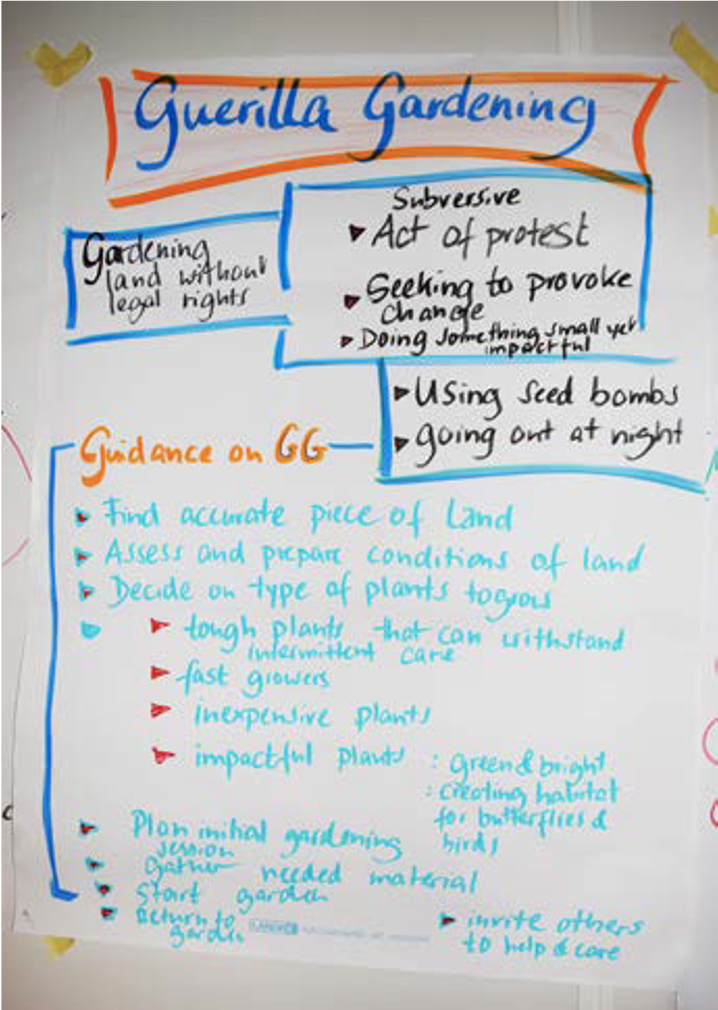Summary
Guerrilla Gardening originally described the act of gardening a piece of land without having the legal right to do so. It is usually seen and done as a subversive act of protest, something small yet impactful, that seeks to provoke change. Transferred into the world of organisations it is used as an approach towards organisational change that also starts informally.
Guerrilla Gardening as a concept can thus be understood as a subversive approach to organisational change. Rather than changing culture from the top with a great proclamation, the idea is that anyone can start cultural change anywhere in the organisation, even in areas that have been rather neglected so far, by building practical small-scale examples of the desired future.
It focuses on triggering communication on desired change that supports the concept of emergent change – change that takes place through discourse and new ways of communication rather than in a planned and controlled fashion.
Hence, Guerrilla Gardening is about developing creative and feasible ideas for action that are examples of what an envisaged change might look like. The act itself might surprise colleagues and co-workers, and spark and inspire open discussion or follow up developments at a bigger or more profound scale.
Goal/Learning Objective/Expected Output
Developing creative yet doable small-scale interventions and ideas that spark open discussions and have the potential to motivate change at a larger scale.
At the same time, this approach has an empowering effect as it can be applied by everybody in the organisation, supporting the basic notion that everybody ‘can start a revolution’.
Way/level of dealing with subject
Visionary and creative work, generating new ideas and new ways to look at organisational culture and change; triggering communication within a small team.
Application in moderation cycle
Emergence – the phase when new ideas and solutions surface.
The approach is overall a very creative and action-focussed one. It is thus more suited to moments of creating ideas.
Duration
Between 45 minutes and 2 hours.
Group size
No limitation for overall group size to introduce the concept.
Development of concrete Guerrilla Gardening idea(s) needs small groups of two, up to a maximum of five people.
Level of difficulty
Easy
Facilitator
Internal or external facilitator able to give some inspiring examples and guide the group in such a way that they are open for some creative work.
Materials needed
- Flipchart paper
- Markers and crayons in different colours
- All kinds of creative material
Additional resources
Process description
Guerrilla Gardening should generally be part of a multiple step process. Preceding the introduction of the concept might be an overall situation analysis exploring the current situation. This might reveal reasons why there is a need for some kind of organisational change, lead to insights that organisational culture needs to be part of an envisaged change process, or help to understand different aspects of the organisational culture.
Introducing the general idea of Guerrilla Gardening

It’s helpful to start with the original concept and history of how it was developed. Cite some basic principles for the ‘Urban Guerrilla Gardener’ e.g:
- Find an uncared-for peripheral piece of land, a wall, a tree – best in your own neighbourhood.
- Decide what you want to plant and check if your choice makes sense. Tough plants and fast-growing flowers are a good start.
- It’s more fun together – find partners. Talk to friends and neighbours.
- Build your garden. Possibly you need to bring some fertile soil and water the plants after planting.
- It may be wise to protect your garden from the challenges of city life, possibly with an improvised little fence against dogs and feet.
- Care for your garden with love! Go regularly and water it.
- If things go differently than planned, don’t lose faith! Talk to residents! Most of them will like your action and at least give you moral support. Some may even join you!
- You will find other principles online.
After the discussion of the original concept, translate it to the world of organisations.
The group splits up into small working groups. Participants should use a variety of different creative materials to inspire experimentation with ideas, not just being analytical but also intuitive. Alternatively, the working groups could go on a walk together as a first step for applying the concept to their own organisation and come up with first ideas.
Guerrilla Gardening ideas should somehow be documented – either in the form of a drawing or a three-dimensional arrangement. Ideas will then be fed back into the large group, asking for feedback.
The last step would be a more in-depth discussion on how to operationalise the ideas, following some of the basic principles of Guerrilla Gardening (see above).
Options for modification
The Guerrilla Gardening model can also be used in the context of conceptualising the envisaged impact strategy of a project. In the classical impact-oriented approach of project development there is a hierarchy of change processes triggered by a project.
While a project is generally only accountable for accomplishing its direct project objectives (the outcome level of a project), there is nevertheless a need to at least discuss and conceptualise the extent to which a project is expected to contribute to higher-level social change (impact level). Here, Guerrilla Gardening could be one possible approach as compared to the more standard idea of quantitatively scaling-up (innovative) pilot projects or influencing political framework conditions to spark systemic change.
Debriefing options
The main debriefing would usually take place while presenting the ideas and receiving the feedback from fellow participants. A final debriefing could relate more to the basic concept, how helpful it is to think about culture change in such a way and how participants experienced the energy in the group while working creatively (and possibly) with their hands.